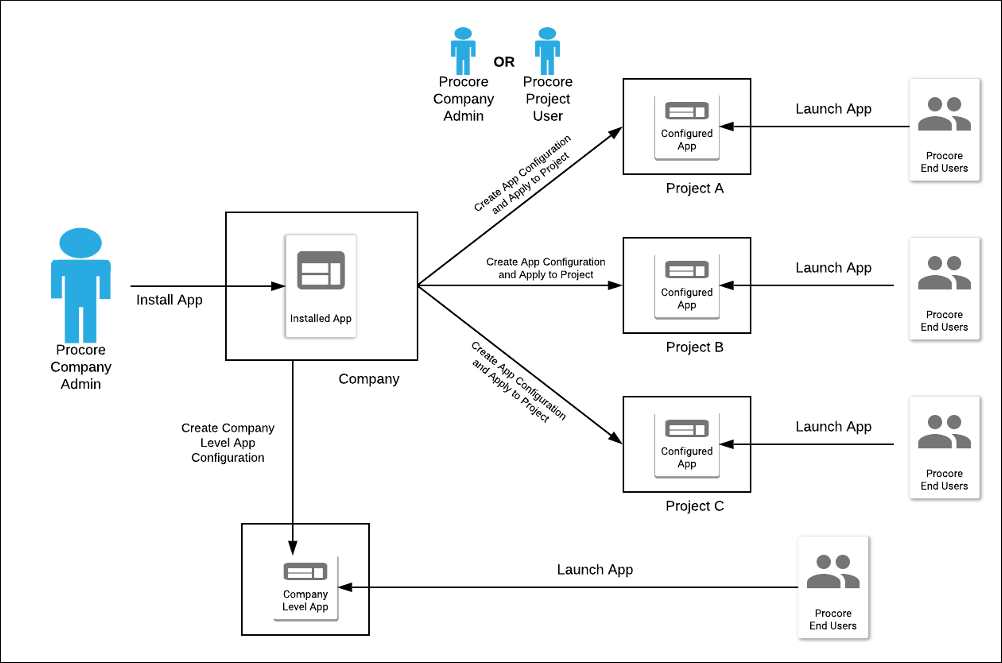What is App Management?
Background
Procore's App Management feature allows Procore company administrators to install and manage third-party applications or Apps, on the Procore platform making them available for use in projects.
Types of Apps
The Procore platform supports different App types. At a basic level, Apps running on the Procore platform fall into two categories - embedded Apps and data connection Apps as described below.
- Embedded Apps - are launched from and display directly within the Procore web user interface. By eliminating the need to switch between Procore and external services and sites, embedded Apps provide a seamless experience for users and help improve efficiency and streamline workflows. Custom third-party Apps developed by Procore customers well as Marketplace Apps developed by Procore technology partners can take advantage of the embedded experience.
- Data Connection Apps - address the need to import, export or sync data between Procore and external applications or services. Custom third-party Apps developed by Procore customers well as Marketplace Apps developed by Procore technology partners can be implemented and deployed as data connectors.
App Management in Procore
Embedded Apps and data connection Apps are managed in Procore using the App Management feature of the Procore Company Admin tool. Once a third-party App is installed in a company, Procore company administrators and project users can use App Management to perform a variety of tasks. With data connection Apps, company administrators can update, uninstall and reinstall Apps as well as view a graph showing the number of daily API requests made by the App. With embedded Apps, company administrators and project users have access to additional functionality including installing embedded Apps directly from the Procore Marketplace, installing custom embedded Apps, creating App configurations at the company and project levels and more. App configurations provide a powerful and flexible way to manage Apps and how your organisation consumes them.
App Management at the company level is accessed through the Company Admin tool (Portfolio > Core Tools > Admin > App Management). App Management at the project level is accessed using the 'Select an App' menu on the top navigation header (Select an App > Explore > App Management).
App Installation and Configuration
Before Procore company administrators project users delve into managing and using Apps, it is important to understand the architecture of App installation in Procore. The following diagram depicts how Apps are installed, configured and launched in Procore.

- The Procore company administrator installs an App in their company account.
- An App can either be configured by an administrator at the company level for access by all users or at the project level with customised project-specific settings. Project level configurations can also be applied globally to all active and future projects.
- For project level Apps, company administrators or project users are allowed to create App configurations and apply them to the projects.
- The same App may be configured differently in different projects.
- Procore end users access configured Apps by launching them directly from within Procore.
Application Versioning and Update Notification
The applications and integrations you install in your Procore company account follow a semantic version numbering scheme. Semantic versioning involves a set of rules that guide how version numbers are assigned and incremented by the application developer. Semantic versioning is beneficial as it provides meaning about the underlying application code and what has been modified from one version of the application to the next.
A semantic version number takes the form X.Y.Z where X is the major version, Y is the minor version and Z is the patch version (major.minor.patch). As you update applications in your company account, version number elements are incremented depending on the type of change:
- major - incremented when incompatible breaking changes are made to the application.
- minor - incremented when new features to the application are released in a backward-compatible manner.
- patch - incremented the when bug fixes or other changes not directly affecting the functionality of the application are released.
To learn more about semantic versioning concepts, visit https://semver.org/.
When a new application version is released by a developer, the App Management listing for the application will have an 'Update Available' notification.

Update notifications for Marketplace applications appear once the new application version is reviewed by Procore and published to the Marketplace. Update notifications for custom-installed applications appear when the developer promotes a new application version to the production environment. In this scenario, the developer must provide you with an updated App Version ID in order to complete the update.
See Update an Installed App for steps to update an application in App Management.